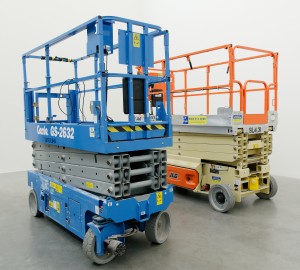 Print a Sign-In Sheet | Spanish Version
Print a Sign-In Sheet | Spanish Version
Aerial lifts offer workers a safe work platform that will provide access to hard-to-reach or temporary locations while being relatively easy to move and relocate. Unfortunately, there can be severe injuries or fatalities when they are not used properly. Major causes of accidents include:
- Falls when the lift is struck by vehicles or objects fall onto the user.
- Falls while working outside of the rails.
- Being crushed or caught between work platform/bucket edge and an object.
- Ejection from work platform due to wind or sudden jerks.
- Tip over due to boom collapse.*
- Falls when lift suddenly jerks.*
- Tip over due to steep slope, rough, or unstable terrain.*
- Electrocution when coming into contact with overhead power lines.*
*Inspections may prevent these accidents.
Inspection Requirements
- Familiarize yourself with the lift and manufacturer’s operating manual prior to inspecting equipment.
- Walk all paths you will travel and look for hazards – wires, other work in the area, overhead power lines, etc.
- Check all surfaces and ground conditions prior to beginning work.
- Check the wheels and tires.
- Check safety devices, such as outrigger and guardrails.
- Check all operating and emergency controls – both ground and upper controls.
- Check your own personal fall protection equipment and know where to anchor.
- Immediately report any unsafe conditions.
Basic Rules for Operator Safety
- Aerial lift operators must receive formal training on the particular make and model prior to use.
- Read the manufacturer’s manual before using for the first time.
- Identify all manufacturer-approved anchor points.
- Refresh your safety knowledge by rereading the manufacturer’s manual quarterly – rental equipment manuals do change.
- Never operate and always report unsafe equipment to supervision.
KEMI does not assume liability for the content of information contained herein. Safety and health remain your responsibility. This information is to be used for informational purposes only and not intended to be exhaustive or a substitute for proper training, supervision, or manufacturers’ instructions/recommendations. KEMI, by publication of this information, does not assume liability for damage or injury arising from reliance upon it. Compliance with this information is not a guarantee or warranty that you will be in conformity with any laws or regulations nor does it ensure the absolute safety of any person, place, or object, including, but not limited to, you, your occupation, employees, customers, or place of business.

